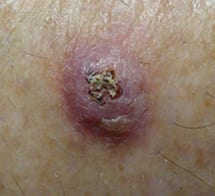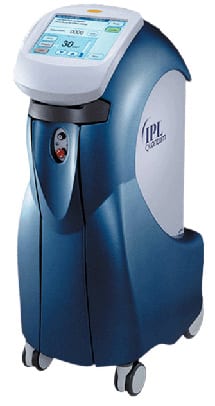Keratoacanthoma
Serving Hamilton, Stoney Creek, Grimsby and surrounding areas
Keratoacanthoma:
- Is often mistaken as a boil or pimple initially
- Grows very rapidly, usually over a period of a few weeks
- Is a type of squamous cell carcinoma
- Is thought to originate from a hair follicle
- Is a skin cancer of intermediate severity
- Does not spread internally
- Is not lethal
- Is caused by sun exposure, from many years before the cancer develops
Prevention of Keratoacanthoma, and other skin cancers:
- Wear a hat with a broad brim and protective clothing (e.g. long sleeves)
- Avoid the outdoors when the sun is strongest between the hours of 10 am to 3 pm
- Use a sunscreen year round with an SPF of at least 30
- Wear a sunscreen which resists water and sweating and which protects against both UVA and UVB
- Reapply sunscreen every hour if you are in water or sweating heavily
- Wear sunscreen even if you are in the shade, it is still possible to burn
- Avoid tanning beds
- The ultraviolet light tanning beds produce is known to cause skin cance
Treatment
Electrodessication and Curettage (Small Keratoacanthoma):
- The skin around the keratoacanthoma is injected with a local anesthetic to numb the area
- The injection stings for a few seconds
- After this, there is no pain or discomfort
- The keratoacanthoma is removed from the skin in a scraping motion with an instrument called a curette
- As the area is numb from the anesthetic, this process is not painful
- The curetted area is then treated with electrocautery, a hot electric needle
- This is not painful as the area is still numb
- Electrocautery stops and bleeding and kills any residual cancer cells
- The lesion is scraped and cauterized a total of 3 times in one visit
- No stitches are required
- Antibiotic and a bandage are used to cover the wound
- The day after surgery, the bandage should be removed and a small amount of antibiotic should be be applied
- This should occur twice daily site is healed
- Redness, pain, swelling or a discharge from the wound may be a sign of infection
- The doctor should be informed immediately
- You may bathe, shower and do your normal activities unless the keratoacanthoma that has been removed is very large and there is a risk of the wound being damaged
- The doctor will inform you about this
- There is a small chance that the keratoacanthoma could grow back
Surgical Excision (All types of Keratoacanthoma):
- The skin around the keratoacanthoma is injected with a local anesthetic to numb the area
- The injection stings for a few seconds
- After this, there is no pain or discomfort
- The keratoacanthoma and a small amount of surrounding normal skin is cut with a scalpel and removed
- As the area is numb from the anesthetic, this process is not painful
- Stitches are used to close the opening
- Antibiotic and a bandage are used to cover the wound
- The day after surgery, the bandage should be removed and a small amount of antibiotic should be be applied
- This should occur twice daily until the stitches are removed
- Redness, pain, swelling or a discharge from the wound may be a sign of infection
- The doctor should be informed immediately
- The stitches are removed in 5 to 10 days
- The removal of stitches is painless
- You may bathe, shower and do your normal activities unless the keratoacanthoma that has been removed is very large and there is a risk of the wound being damaged
- The doctor will inform you about this
- There is a small chance that the keratoacanthoma could grow back
Radiation (All types of Keratoacanthoma):
- To receive radiotherapy of a keratoacanthoma, the lesion must be biopsied (sampled) first
- To do the biopsy:
- The skin around the keratoacanthoma is injected with a local anesthetic to numb the area
- The injection stings for a few seconds
- After this, there is no pain or discomfort
- A small portion of the keratoacanthoma is removed
- As the area is numb from the anesthetic, this process is not painful
- Stitches are usually not necessary to close the opening
- The biopsied area is then treated with electrocautery, a hot electric needle
- This is not painful as the area is still numb
- The electrocautery is used to stop any bleeding
- Antibiotic and a bandage are used to cover the wound
- The day after surgery, the bandage should be removed and a small amount of antibiotic should be be applied for 1 week
- Redness, pain, swelling or a discharge from the wound may be a sign of infection
- The doctor should be informed immediately
- If stitches were used, they are removed in 5 to 10 days
- The removal of stitches is painless
- You may bathe, shower and do your normal activities after the biopsy
- Once the biopsy result is available, the doctor will make a referral to a radiation specialist
- In Hamilton, the radiation treatments and specialists are located at the Juravinski Cancer Centre next to the Henderson General Hospital
- The first visit with the radiation specialist is for an assessment only
- If he or she agrees with your doctor that the lesion is suitable for radiation, treatments will be arranged
- Most keratoacanthomas require 10 to 15 treatments
- These are done daily, Monday to Friday over a period of 2 to 3 weeks
- After the radiation is complete, the spot will become red, scabby and crusted
- This will heal over the next few weeks
- There is a small chance that the keratoacanthoma could grow back
Mohs Micrographic Surgery (Complicated Keratoacanthoma) :
- Mohs micrographic surgery is a detailed surgical procedure to treat aggressive non-melanoma skin cancers, mainly on the face and neck
- This treatment is usually reserved for the most complicated cases
- For appropriate patients in the Hamilton area, referrals are made to the Mohs Centre at Women’s College Hospital in Toronto
- Initially, the diagnosis must been confirmed with a biopsy (see above), prior to the referral being made
Would you like to see a Video Demonstration?
- I am pleased to offer a new section on the website with video demonstrations of various procedures
- To watch a video-clip in which Dr. V talks about:
- Levulan PDT Treatments, please click here
Keratoacanthoma – Shoulder
Keratoacanthoma – Temple
What if you are interested to learn more?
If you would like to learn more please phone the aesthetic centre directly at (905) 549-7873 to book a free consultation with one of our knowledgeable technicians or








